Planning A Pet Trust
AJ Fudge, Estate Planning Attorney
 What happens to your pet if something happens to you? Did you know your pet is considered "property" in the eyes of the law? Estate Attorney A.J. Fudge has prepared a simple plan for your pets should you punch the clock before they do. It's important to have a pet-trust legally documented so that your furry-family member doesn't end up in the shelter and possibly euthanized.
What happens to your pet if something happens to you? Did you know your pet is considered "property" in the eyes of the law? Estate Attorney A.J. Fudge has prepared a simple plan for your pets should you punch the clock before they do. It's important to have a pet-trust legally documented so that your furry-family member doesn't end up in the shelter and possibly euthanized.
For those that don't know, pets are your family, but they are property in the eyes of the law. That means that when you pass away, the government could determine ultimately who inherits your animal. AJ Fudge is an estate planning attorney who explains what happens to your pet if something happens to you.
Being property, animals are subject to the same rules and procedures that would apply to any of your other property. It also depends on what kind of estate planning you've done. If you do what is commonly called as the, "Do Nothing" approach, which is to just hope for the best, this usually results with animals winding up in shelters and eventually euthanized, because no one wants to deal with them.
Animals are a burden and they are an expense. Most people, unless they truly love that animal or are looking forward to having that animal in their home, they are not going to take it in, so the shelter is the next step for the animal. This is what happens to a lot of animals in the United States. If the owner does not do any planning for the animal, that is unfortunately the end result.
That's the, "Do Nothing" plan, which costs you absolutely nothing. What are the, "Do Something" plans? These plans are the same type of planning that you would do for other aspects of your property. For example, in California, most people do have a revocable living trust. The reason that they have a trust is because the probate procedures in California are very time consuming and they're also very expensive. California has abnormally high fees involved with a probate and probate's are what will happen to your property if you either do nothing or if you rely on a will for your estate planning. Because most people want to avoid, for example, the time delay and the fees, they put a trust in place.
AJ Fudge tells us she did a probate last year and the people actually had a trust in place, but they had forgotten to put a piece of property in the trust. So they had to probate a single piece of property. That probate lasted 24 months and they paid almost $7,000 in fees.
What if you don't want to deal with all the lawyers and want to ask your good friend and neighbor to take care of your animal if something happens to you and you will leave her $5,000, would that work? AJ Fudge explains that could work and it's certainly better than doing absolutely nothing. However, you still need to have some legal documents in place to show that your friend is now the owner of the animal if you pass away. This is also necessary if something were to happen to you and you were incapacitated, your friend would need to be able to prove that she has the power to make decisions regarding the animal and take care of it just as they would any other item of property. In this case, you could do a power of attorney or maybe a will to accomplish the simplest form of estate planning. The issues with doing that is that a will is still going to be subject to probate, so there's going be a delay there and expense involved. Even if you don't want to involve an attorney, the court basically will take all those fees anyways.
The main thing in this case is that you want to plan around too is if something were to happen to your friend, then your animal is right back in the same position if your friend hasn't done any planning or if you don't have a backup in place for your friend.
So for people that are really looking to just make sure that their animal never ends up in a shelter, you would transfer ownership of the animal to your trust, which you have in place for estate planning purposes. Make sure you put your animal in the trust as well and name some caretakers. Set aside that money instead of giving the money to the caretaker directly. This is done through the trust so that the money has to be used for the animal and it can't be used for gifts to their relatives or their own personal expenses or things like that.
 Okay, so you want to provide for your cat if anything should happen to you. How much should you leave for them? AJ Fudge explains that it depends. Her clients ask her that question all the time and she says it depends on how old the cat is and what kind of life the cat is living now. For a regular cat that just leaves a pretty standard life, she says you can leave anywhere from around $2,500 to 5,000. And the caveat on that is that money is used to take care of the cat for their food, medical expenses, boarding, that kind of thing. Anything that's leftover from that can still just go to your beneficiaries. She claims it's usually better to err on the side of too much rather than too little, just because if you don't leave enough then there's an issue with where are those funds going to come from. If you do leave too much, it's not a big deal because that money is just going to go to whoever your beneficiaries are anyways. AJ explains she's also had clients at the other end of the extreme where they just pass the cat off to a friend with the money.
Okay, so you want to provide for your cat if anything should happen to you. How much should you leave for them? AJ Fudge explains that it depends. Her clients ask her that question all the time and she says it depends on how old the cat is and what kind of life the cat is living now. For a regular cat that just leaves a pretty standard life, she says you can leave anywhere from around $2,500 to 5,000. And the caveat on that is that money is used to take care of the cat for their food, medical expenses, boarding, that kind of thing. Anything that's leftover from that can still just go to your beneficiaries. She claims it's usually better to err on the side of too much rather than too little, just because if you don't leave enough then there's an issue with where are those funds going to come from. If you do leave too much, it's not a big deal because that money is just going to go to whoever your beneficiaries are anyways. AJ explains she's also had clients at the other end of the extreme where they just pass the cat off to a friend with the money.
There are also cases where perhaps someone has an elderly cat or a group of cats that are living in the house together and they want to make sure all these cats can stay together and stay in their home. Those types of plans are a little bit more elaborate. The planning that she does and the money that's set aside also increases for that type of thing because you're not just looking at a single animal, you're looking at a group of them and then possibly maintaining a home for them as well.
So what if you are going to leave $10,000 for the care of your cat. How do you ensure that someone isn't going to euthanize your cat and pocket the money? You know, just thinking bad things happen. AJ tells us that's really where you're getting a lot of benefit when you do this through an animal care trust. You have the money set aside in the trust for your pet. Then, your trustee oversees everything for your items of property and your other accounts and even the caretaker who's actually taking care of the animal.
There's a check and balance system in place to make sure that the caretaker isn't doing anything. There's a trustee in place to kind of oversee everything just like there would be with a child and you're leaving money to the child and the child's guardian. Obviously, you want to make sure that that money is used for the child or for the animal and that's what the trustee's job is. They are actually under a fiduciary duty, which is one of the highest duties of loyalty that you can have under the law to make sure that all trust funds and trust goals are met. And if they're not, they can face a tremendous amount of liability. So most trustees are very conservative and make sure that things are being followed to the letter.
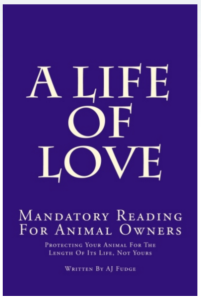 What age should we get a pet care trust? None of us have a crystal ball and unfortunately something can happen in a blink of an eye. AJ suggests that if you have children or animals or any kind of substantial property, that's the trigger for doing some estate planning. This is especially for children and animals, as they cannot speak for themselves. They don't have much of a voice and animals are treated as property under the law, so they have even fewer rights than a child would. They also don't have any advocates appointed for them. It's the responsible thing to do some sort of planning for your animal just like you would for your child as soon as you have one.
What age should we get a pet care trust? None of us have a crystal ball and unfortunately something can happen in a blink of an eye. AJ suggests that if you have children or animals or any kind of substantial property, that's the trigger for doing some estate planning. This is especially for children and animals, as they cannot speak for themselves. They don't have much of a voice and animals are treated as property under the law, so they have even fewer rights than a child would. They also don't have any advocates appointed for them. It's the responsible thing to do some sort of planning for your animal just like you would for your child as soon as you have one.
All too often animals are surrendered to shelters and euthanized, because something has happened to the animal's owner. This is a heartbreaking thought for any animal owner. The good news is that planning for your animal is easy to do and having a plan in place guarantees that this will never happen to your animal.
AJ Fudge has covered everything you need to know in her book, "A Life of Love: Mandatory Reading for Animal Owners." She states this book was written as a call-to-action to encourage animal owners everywhere to put a plan in place to protect their animals. The book takes a clear, straightforward approach to give you the information you need to guarantee that your animal is protected. The goal is to keep all of our beloved animals out of shelters and in loving homes.
The reason for the book is that AJ was tired of seeing all of the animals that were listed on Humane Society websites or the local animal websites where something had happened to an animal's owner and that the animal was now looking for a new home.
AJ states that you should also not rely on a Will to protect your animals. There are a lot of rules when it comes to Wills, with the main problem being that you can't put any conditions on the property that you transfer.
Visit Website
TV Show Presents Where to Vacation With Your Pets
Heather Eisenstadt, Pets Welcome Here TV
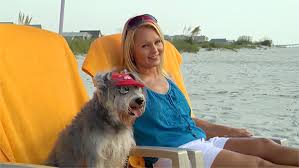 Pets Welcome Here is America's top pet travel TV show. They are traveling all over the country showing the audience amazing experiences that they can share with their pets in great pet friendly destination.
Pets Welcome Here is America's top pet travel TV show. They are traveling all over the country showing the audience amazing experiences that they can share with their pets in great pet friendly destination.
Pets Welcome Here TV is in syndication all over the country. They are in key markets including New York City, Philadelphia, Atlanta, Detroit, Minneapolis, St Paul, Orlando, Tampa, just all over the country. The best way for people to find out where to see the show on their local station is to go to the website, Pets Welcome Here TV and look for the schedule, which will be up in the menu. Click on the schedule, and you'll see all the cities all over the country that are carrying the show, what stationed it will be on and what time it will be on.
Heather Eisenstadt is the brainchild of Pets Welcome Here TV. So why did she create the show? She tells us that if you've ever gone on vacation without your furry kids, you know how heartbreaking it is to leave them behind. You have to look at those faces and the sadness, which hurts you as much as it hurts them. She tells us that she's always had two or three dogs and cats. She started to research where she could go and what are the fun things that she could do with her pets. She then found out that more than three quarters of pet parents said they would take their dogs and their kitties on vacation with them if they knew where they could go. She knew then that a lot of people might enjoy a show where you could discover how to have awesome travel experiences that includes your pets, and so pets Welcome Here TV was made.
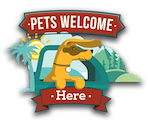 Most people think you need to have a big dog to travel with where you can do things together like hiking. But what are some of the things you can do with a small dog or even a cat? Heather tells us you would be surprised at how much small pets enjoy historical tours. Even in cases where some of them are actually in strollers. Heather has seen a lot of people with small dogs and cats in strollers touring historical cities like Philadelphia or Williamsburg. You can even go to great places like St. Augustine and see the fountain of Youth Archaeological Park.
Most people think you need to have a big dog to travel with where you can do things together like hiking. But what are some of the things you can do with a small dog or even a cat? Heather tells us you would be surprised at how much small pets enjoy historical tours. Even in cases where some of them are actually in strollers. Heather has seen a lot of people with small dogs and cats in strollers touring historical cities like Philadelphia or Williamsburg. You can even go to great places like St. Augustine and see the fountain of Youth Archaeological Park.
To learn where you can take your pet on vacation, visit Pets Welcome Here TV. Go to the schedule, click on it, and you'll see where and when we will be on in your area.
Visit Website
The World's First Self-Cleaning Dog Potty Goes To The Rescues
Alan Cook, BrilliantPad
 Alan Cook, the inventor and mastermind behind the Brilliant Pad Self-Cleaning Dog Potty, is donating hundreds of potties to shelters and adopters across America. "By potty training shelter dogs, we're helping to make more dogs adoptable," says Cook. Shelters may apply here.
Alan Cook, the inventor and mastermind behind the Brilliant Pad Self-Cleaning Dog Potty, is donating hundreds of potties to shelters and adopters across America. "By potty training shelter dogs, we're helping to make more dogs adoptable," says Cook. Shelters may apply here.
About two years ago the BrilliantPad was introduced to the Animal Radio studios. Judy Francis was in charge of cleaning the dog potty and constantly replaced the soiled pads and washed the artificial grass. She had tried many different types of indoor dog potty products over the years, never finding anything that was easy and that she liked. She was always looking for the answer to this problem and then she had it. The BrilliantPad has made a big difference in her life and that of her dog's, Ladybug. She swears by this product and will never let anyone ever take it away!
BrilliantPad has been around several years now and is growing by leaps and bounds. They now they have a shelter program and Alan Cook, the Found and CEO of BrilliantPad, explains to us how it works.
Alan explains that they are so excited and happy to support the animal community by donating free products to animal rescue organizations and shelters. Adoption season is starting and shelters have all sorts of events and fundraisers, so they are donating free BrilliantPads to their friends in the animal community to support their fundraising activities.
 They are doing this three different ways. BrilliantPads will be given free to rescues and shelters for their silent auctions and raffles. They will also donate them to rescues and shelters for fundraisers and they get to keep all of the proceeds. They don't have to pay for them or give up any commissions. They get to keep all that they raise in their silent auctions and raffles.
They are doing this three different ways. BrilliantPads will be given free to rescues and shelters for their silent auctions and raffles. They will also donate them to rescues and shelters for fundraisers and they get to keep all of the proceeds. They don't have to pay for them or give up any commissions. They get to keep all that they raise in their silent auctions and raffles.
The second thing that BrilliantPad is doing is providing machines to be used in the shelter facilities and the homes of foster families. So they're doing their part to make taking care of these dogs even easier.
The third thing they're doing is giving away free BrilliantPads to people that adopt dogs from participating shelters and rescue organizations. All the shelter has to do is distribute a postcard that they provide in the adoption packet and BrilliantPad will do the rest.
BrilliantPad is a great company that puts their money where their mouth is and has not only created an amazing product, they're actually helping the animals out there get from shelters and horrible situations into families and wonderful situations.
They also know that one of the biggest challenges the animal community has in placing young dogs is the whole house training part. So in some cases, because the shelters and rescue homes are using the BrilliantPad, the dog is coming pre-potty trained. It's a nice point to the adopting family to make life that much easier when they get their new puppy home.
If you are working with a shelter or foster families and want to know how they can get involved, visit either brilliantpad.com/shelters or send an email to shelters@brilliantpad.com. Tell them a little bit about your shelter, what events you have coming up and let them know the best way to get in touch with you and they will get you set up.
 If you're not with a shelter, but you're pretty interested in how Judy's life has changed and this is something you want to think about visit brilliantpad.com.
If you're not with a shelter, but you're pretty interested in how Judy's life has changed and this is something you want to think about visit brilliantpad.com.
BrilliantPad is a great company that puts their money where their mouth is and has not only created an amazing product, they're actually helping the animals out there get from shelters and horrible situations into families and wonderful situations. They are doing everything they can to support the animal community and are thrilled to be giving back.
Visit Website
What's Trending In The Pet Sector?
Robert Semrow, Pet World Insider
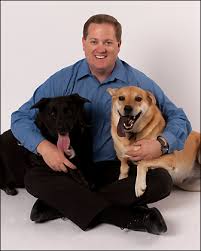 On the heels of the industry's largest pet product show, Robert Semrow reports on the latest and greatest stuff for your pets. This year has seen an explosion of CBD type supplements, a bi-product of marijuana, for moderating your pet's pain. Also, a large number of major companies are launching their products on Kickstarter. If the product doesn't gain traction through crowd-funding, then it's shelved. This new technique saves thousands in market research.
On the heels of the industry's largest pet product show, Robert Semrow reports on the latest and greatest stuff for your pets. This year has seen an explosion of CBD type supplements, a bi-product of marijuana, for moderating your pet's pain. Also, a large number of major companies are launching their products on Kickstarter. If the product doesn't gain traction through crowd-funding, then it's shelved. This new technique saves thousands in market research.
One of the interesting things that Robert saw from some of the manufacturers was the way that they were reaching out and not only marketing but also bringing products to the market. One of those examples would be some of the folks were actually approaching him about things that they were going to be putting onto Kickstarter and other Crowdfunding resources, because they felt that was going to be a great way for them to kind of test out the viability of the product with the Millennials. This whole area has exploded and we're really seeing more of an emphasis of reaching out to the Millennials. It's really been the other way in years past this year.
So you're seeing even big established companies using Kickstarter to introduce products? This is interesting, because you may not know that it's actually a bigger company. It may be a subset or someone that they're working with in their development program. We've seen so many of these products over the year, as most people in the media have been approached to share information about products with their audience.
The reality is that's also a great way to see if a product is viable and if there's a real interest out there. Robert tells us that there are some items where we think nobody's going to be interested and then it gets Crowdfunded, which takes it in a whole new direction. Robert believes the bigger companies are really taking a look at that and saying, "You know what, here's a great way to do additional market research." So that's what they're doing, which is actually pretty wise. If they can find the funding on Kickstarter, then it might be a viable product and if not, perhaps they will shelf the idea. But surprisingly, some companies indicated to Robert that they were still going to come out with these products, as they've put a lot of time and research energy into the product. By doing this, they get good feedback as well from social media and pet parents who say they really like the product, but if they made a tweak here or a tweak there, they could improve on it, which is really clever.
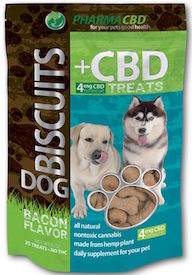 Another big item this years are CBDS or Cannabidiols. SuperZoo is huge, and Robert tells us that you could not walk one aisle not see CBDS. Robert is very passionate about CBDS and spent a lot of time in this area at the show. He feels that a lot of companies are getting into for their foods and treats and are just flooding the market. Robert believes that when folks start to really understand the benefits, they will be more open about it.
Another big item this years are CBDS or Cannabidiols. SuperZoo is huge, and Robert tells us that you could not walk one aisle not see CBDS. Robert is very passionate about CBDS and spent a lot of time in this area at the show. He feels that a lot of companies are getting into for their foods and treats and are just flooding the market. Robert believes that when folks start to really understand the benefits, they will be more open about it.
Robert says he has used CBDS on his owns pets, so have his friends, and everyone claims it helps their pets. He thinks the acceptances there, now that next step is where is the quality control? How is this being grown? How has it been processed? Much like Tumeric, it's got to be activated, so what's that process? And then you get into things like, in that activation process, a lot of times much liking the food and treat world, we're seeing it being cooked or heated for an extended period of time. That brings down the terpenes, flavonoids and the CBD levels, and then synthetically it's being built back in. Robert believes once folks start to realize and understand this much like we've seen in food, much like we've seen it treats, we're going to see folks demanding more transparency in that labeling and saying they want it to be all natural and organic. They want it to be the best that it can be if it's going to have those healing properties that they're looking for.
CBDS were just everywhere at the show, explains Robert. It's also in a variety of products too. It's not just in oils or in treats. There are also salves, capsules and powders. It was also mixed in with catnip. Roberts believes that CBDS are going to be something that not only our pets are taking on a daily basis in the future, but also all of us will be taking. That's probably not something he would have said two or three years ago, so that was definitely an explosion on the show floor.
If you want to know if CBDS will benefit your pet, work with your veterinarian.
Visit Website
Will Your Dog's Chew Bone Injure Her Teeth? - Dr. Debbie
 Even veterinarians can make bad choices when it comes to their pet's health. I learned this when I discovered my dog, Nikki, had a broken tooth. The cause was a chew item I thought was a safe option for her to gnaw on. But I was wrong - no chew item is risk free. Sadly my Nikki had to crack three teeth for me to learn that lesson.
Even veterinarians can make bad choices when it comes to their pet's health. I learned this when I discovered my dog, Nikki, had a broken tooth. The cause was a chew item I thought was a safe option for her to gnaw on. But I was wrong - no chew item is risk free. Sadly my Nikki had to crack three teeth for me to learn that lesson.
Oh yes, it was three broken teeth! But more on that later...
Considering Chew Options
What chew options are there? As the owner of a large powerful chewer I considered the possibilities for my dog. She has a sensitive stomach and cannot tolerate edible bones or preserved rawhide products. Thank goodness, because feeding my dog pig snouts or pizzles just makes me want to gag. I'm not a fan of real bones - too many patients with broken teeth, gastrointestinal blockages and even one with a bone shard migrating through the side of a dog's throat. Soft plastic toys don't survive the first two minutes with her, and plush toys quickly lose eyes, limbs and squeakers with her near surgical precision. So I chose to offer synthetic Nylabone style bones to deal with her chewing drive. Nikki loves the flavors and happily chews away for long periods of time. When the bone looks damaged, I throw it away. It seemed like the perfect solution for a vigorous chewer.
Discovering Her Broken Tooth
While brushing Nikki's teeth, I noted a fracture of her upper fourth premolar tooth. This is the largest cheek tooth on a dog or cat's upper jaw, which serves to chew and grind food. The outer layer of the tooth was sheared off, just like a shelf of ice cracking off an iceberg. This type of fracture is common from dogs chewing on an object harder than tooth enamel. Common culprits for this type of tooth damage include antler chews, Nylabones, real bones or ice.
What to Do With Broken Teeth?
Not all tooth fractures are created equal. An uncomplicated tooth fracture is one in which only the enamel is broken. The tooth is vulnerable to further injury but is not immediately causing the pet pain. A complicated fracture is one in which the break extends beyond the enamel into the pulp chamber.
The pulp of a tooth is the inner layer where the nerve and blood supply runs. Exposure of the pulp not only causes pain, but serves as direct pathway for oral bacteria to cause a tooth abscess or spread through the bloodstream.
How to Treat a Tooth Fracture?
A complicated tooth fracture requires either a root canal or surgical extraction. Leaving a complicated tooth fracture untreated is NOT an option. These teeth hurt and shouldn't be ignored. Pets won't whine or cry out in pain with broken teeth, but rather suffer in silence. But after a diseased tooth is addressed, owners commonly note their pet's overall activity and attitude improve.
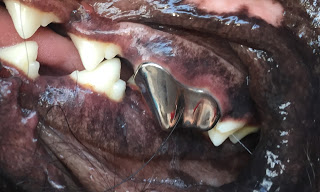 The preferred treatment for a complicated tooth fractures is a root canal. During a root canal the contents of the pulp are removed, filled in, and the tooth is sealed. After the root canal therapy the tooth is still functional for normal chewing activities.
The preferred treatment for a complicated tooth fractures is a root canal. During a root canal the contents of the pulp are removed, filled in, and the tooth is sealed. After the root canal therapy the tooth is still functional for normal chewing activities.
If a root canal cannot be pursued, then the tooth should be surgically extracted. This removes the source of pain and potential infection. However, surgical removal of broken teeth may affect the pet's ability to chew on that side in the future.
Uncomplicated tooth fractures aren't treated as above, but rather may need outward support of the area with bonding restoration.
My Dog's Dentist Visit
Dental cleanings and extractions are a daily service at most veterinary practices, but root canals and tooth restorations aren't commonly available at general practices. I knew I could pull Nikki's tooth, but to save this tooth in my young dog, I'd need to see a veterinary dental specialist.
Nikki and I arrived at Arizona Veterinary Dental Specialists where she was evaluated by Dr. Chris Visor who determined that she had an uncomplicated fracture of her premolar and small uncomplicated breaks on two molars.
Her premolar fracture was limited to the enamel, luckily sparing pulp damage, which means she wasn't in pain. But the damaged tooth would be at risk for further injury, so she was fitted for a restoration with a metallic crown (porcelain isn't durable in pets so it's not commonly used). The two other broken teeth had minor damage, so the rough edges were drilled smooth and the tooth surface bonded.
Lesson Learned
After her crown placement, Nikki can't chew on hard chew bones like before. If she did, it could risk damage to her crown as well as her other teeth. Veterinary dentists warn dog owners to try this test of your dog's chew item - if you whack your knee with your dog's chew item and it hurts you, it'll likely break her teeth.
Now I can only imagine scores of dog owners going to their doctors with knee pain….
Take Away Tips: Can You Detect Your Pet's Broken Tooth? Most broken teeth are detected during a physical exam by your veterinarian, but some observant pet owners may discover clues to their pet's broken tooth.
1. No complaining. Don't expect your pet to cry or whine. People complain loudly when a tooth hurts, but pets just don't verbalize dental pain.
2. Uneven tartar accumulation. Due to tooth pain, the pet chews on one side more, the "good side." Tartar builds up more on the "bad side."
3. Dark spot on tooth. Enamel is evenly white, but darker or grey spots could indicate exposed pulp or dentin at the site of a fracture.
4. Draining wound present below the eye. A broken upper premolar or molar with an infected root can cause a draining wound under the eye.
If you notice any of these signs, get your dog to a veterinarian right away.
Featured veterinarian known as "Dr. Debbie" on national pet radio program, Animal Radio. Ebook author of "Yorkshire Terriers: How to Be Your Dog's Best Friend"; "Pugs: How to Be Your Dog's Best Friend"; "Mini Schnauzers: How to Be Your Dog's Best Friend"; and "Shih Tzu: How to Be Your Dog's Best Friend." Dr. Debbie's books.
Visit Website
The Dogfather's Grooming Tip with Joey Villani
 "Buyer Beware" When It Comes to Grooming
"Buyer Beware" When It Comes to Grooming
Social media has brought attention to some of the horrible things that are happening to animals by some of the groomers around the country. This is because the professional grooming industry is an unlicensed industry.
Being an unlicensed industry has its pros and cons. Mainly the cons are that anyone can claim to be professional groomer. For some people, if they have a pair of scissors and clippers, they can be dangerous.
Groomers work with equipment that can overheat the pet or injure them. Sometimes even death has occurred at the hands of a groomer.
Right now it's basically "buyer beware,' according to Joey. He is currently working with the state of New Jersey to help develop legislation on getting groomers certified, not licensed. He explains this is because to him certification probably does a little bit more. This is because you've got hundreds of hours of information that has been developed by people who actually know the industry opposed to people who were just appointed by the state thinking that they know what's going on and licensing people.
Joey states he wants people around the country to understand that their groomer is not licensed. So the first thing you need to do is to check their history. Where did they come from? Not every groomer needs to have gone to a grooming school, because they may have been mentored by some of the best people in the world and may be a fabulous groomer. But you still want to ask them questions. You want to tour the facility and you want to make sure that the place looks good. Is it clean? Are the groomers walking away from their tables and the animals?
You want to ask them questions of how do they dry your dog? Dryer kennels are not necessarily bad things. However, they need to be regulated as well as time and temperature controlled, which most of them are. You also need to make sure that they check on your pet while they are in a drying kennel at least every 20 minutes. This is to make sure they're not overheating and they're not overstressed.
Ask questions. If there's one thing you don't like, move on. Go to somebody else. Until the grooming industry is better regulated you need to be the "buyer beware" and you need to make sure that your pet is safe in the hands of a professional pet groomer.
Animal Radio News - Lori Brooks
 What Will Happen to Quality of Food After Nestle Buyout?
What Will Happen to Quality of Food After Nestle Buyout?
The Wall Street Journal tells us Nestle, the huge food and beverage conglomerate, is in talks to buy a majority stake in Canada's Champion Petfoods for $2 billion. Champion makes super premium, high quality, Orijen and Acana dog and cat foods. Because they are known for very high quality pet foods and treats, most people are will to spend more money on them. This news of a bid to take over Champion will upset a lot of pet parents who feed Orijen and Acana, because they buy it knowing above all that it is not made by any of the major pet food manufacturers. The fact that the Orijen and Acana brands are independent and such high quality is exactly why those people are willing to spend so much more for it. That likely won't be the case if Nestle, which owns Purina, takes over Champion and its brands.
Do You Know How Many Colors of Cats There Are?
According to the International Cat Association, there are just two primary colors of cats: black and red. All other colors, with the exception of solid white, are simply variations of black and red. That's because white is a masking gene that hides colors and because their color is hidden by white, cats are genetically black or red. In addition, tabbies are cats with stripes. A tortie is usually a female and mixed black and red genes that show their variations. Add white to that and you have the colors in patches, which are calicos.
 PETA Pushes To Remove All Stock Photos of Primates From Internet
PETA Pushes To Remove All Stock Photos of Primates From Internet
If you're a lover of primates, monkeys, chimps, gorillas and the like, you may not be seeing as many different photos of them in the future. Recently, PETA made a major push in its efforts to stop what it calls harmful portrayals of primates and has successfully lobbied a number of stock photo organizations to remove images that depict primates in an "unnatural" way. They have also asked that they restrict their photos to those taken in zoos or other natural environments. Stock photos are used in everything from advertisements to greeting cards, to websites and newspapers. In the wake of talks with PETA, three major stock photo companies have agreed to go through their catalogues and remove all "inappropriate" images of primates. However, the biggest, Getty Images, has reportedly pledged to go further, eliminating "inappropriate" images of all wild animals.
Is It Live or is It Memorex?
There's more than one-way to catch a cat, or kitten in this case. The cat, according to a local fire department in Maryland produced a volume of vocalizations on Friday morning loud enough to make its presence known to a woman who was driving to a store. It turned out that the kitten was inside the fender of her car. She couldn't reach it, so she called the fire department. At first, the rescuers thought removing the fender might be the best option. But, before trying it, someone captured a video and audio recording of the cat. They played it back and behold, the recorded meow was met with a live meow from the trapped cat that then moved to a more accessible spot. They kept playing the meow recording and the kitten followed it to the bottom of the car when rescuers nabbed it. One of the firefighters and his wife then adopted the cat.
 Christopher Columbus Wiped Out Native Dogs
Christopher Columbus Wiped Out Native Dogs
After a very long investigation and accompanying research, a new study says Christopher Columbus' arrival in the Americas basically led to the complete erasure of native dogs. The study, published in the journal Science, argues that dogs native to the Americas were essentially completely wiped out by the arrival of European dogs in the 15th century. Arbor Biosciences, which assisted with the research, put out a statement saying, "We now know that the modern American dogs beloved worldwide, such as Labradors and Chihuahuas, are largely descended from Eurasian breeds, introduced to the Americas between the 15th and 20th centuries," Dogs native to the Americas did not come from American wolves but rather originated in Siberia and crossed the Bering Strait with humans the spread throughout both continents and became a huge part of Native American cultures.
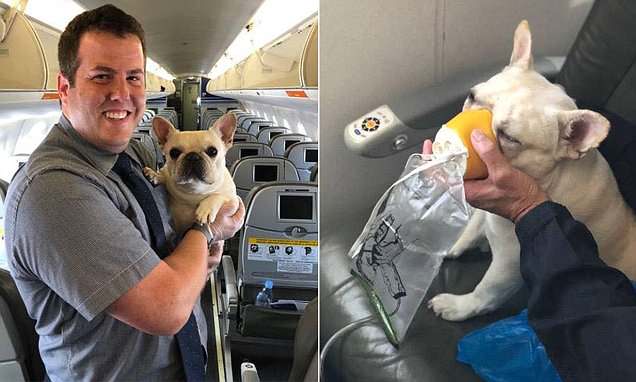 Flight Attendants Save Dog
Flight Attendants Save Dog
Some quick thinking flight attendants saved the life of a French Bulldog on a JetBlue flight. The 3-year-old French Bulldog, named Darcy, was on a flight from Florida to Massachusetts with her human parents when her tongue began to turn blue and she started having difficulty breathing. The flight crew then quickly stepped in with an oxygen mask, which Darcy's mom held over her face until she started to breathe normally. Many airlines ban bulldogs and other smoosh-faced breeds from flying in cargo holds, as they are more prone to respiratory problems. Short-nosed dogs are put at a higher risk for breathing problems when flying because they are more vulnerable to changes in air quality and temperature.
 Listen to the entire Podcast of this show (#972)
Listen to the entire Podcast of this show (#972)





